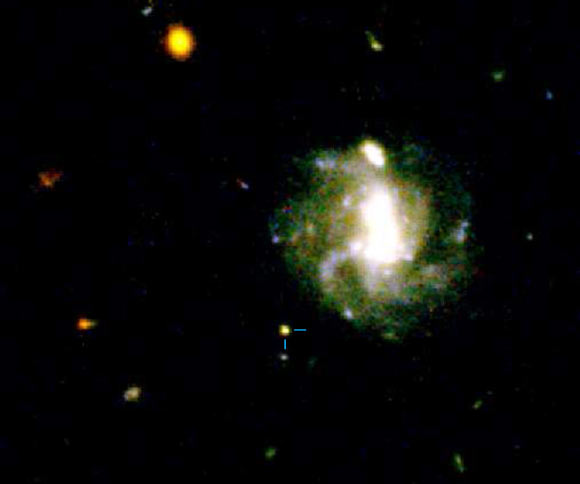Astronomers Detect New Kilonova Explosion | Astronomy – Sci-News.com
Astronomers have re-examined data from GRB 160821B, a short duration gamma-ray burst spotted on August 21, 2016, and found evidence for a kilonova, an extremely powerful explosion that releases large amounts of energy and produces important elements like gold, platinum, and uranium.

GRB 160821B occurred in the outskirts of a spiral galaxy about two billion light-years away, at a projected offset of 52,185 light-years from the galaxy’s center. Image credit: Troja et al, doi: 10.1093/mnras/stz2255.
On August 17, 2017, astronomers made history with the first direct observation of a merger between two neutron stars.
Dubbed GW170817, it was the first cosmic event detected in both gravitational waves and the entire spectrum of light, from gamma rays to radio emissions.
GW170817 also created a kilonova, an extremely powerful explosion that instantly forged several hundred planets’ worth of gold and platinum.
The observations provided the first compelling evidence that kilonovae produce large quantities of heavy metals.
Based on data from GW170817, scientists began to adjust their assumptions of how a kilonova should appear to Earth-bound observers.
In August 2016, they detected a short duration gamma-ray burst, named GRB 160821B.
NASA’s Neil Gehrels Swift Observatory began tracking the event minutes after it was detected.
The early catch enabled the astronomers to gather new insights that were missing from the kilonova observations of the GW170817 event, which did not begin until nearly 12 hours after the initial collision.
The similarities between the two events suggest that the GRB 160821B kilonova also resulted from the merger of two neutron stars.
Kilonovae may also result from the merger of a black hole and neutron star, but it is unknown whether such an event would yield a different signature in X-ray, infrared, radio and optical light observations.
“The information collected from the 2016 event does not contain as much detail as the observations of GW170817,” said lead author Dr. Eleonora Troja, an astronomer at the University of Maryland.
“But the coverage of those first few hours — missing from the record of the GW170817 event — revealed important new insights into the early stages of a kilonova.”
For example, the team got their first look at the new object that remained after the collision, which was not visible in the GW170817 event data.
“The remnant could be a highly magnetized, hypermassive neutron star known as a magnetar, which survived the collision and then collapsed into a black hole,” said co-author Dr. Geoffrey Ryan, also from the University of Maryland.
“This is interesting, because theory suggests that a magnetar should slow or even stop the production of heavy metals, which is the ultimate source of a kilonova’s infrared light signature.”
“Our analysis suggests that heavy metals are somehow able to escape the quenching influence of the remnant object.”
The findings appear in the Monthly Notices of the Royal Astronomical Society (arXiv.org preprint).
_____
E. Troja et al. The afterglow and kilonova of the short GRB 160821B. MNRAS, published online August 27, 2019; doi: 10.1093/mnras/stz2255





